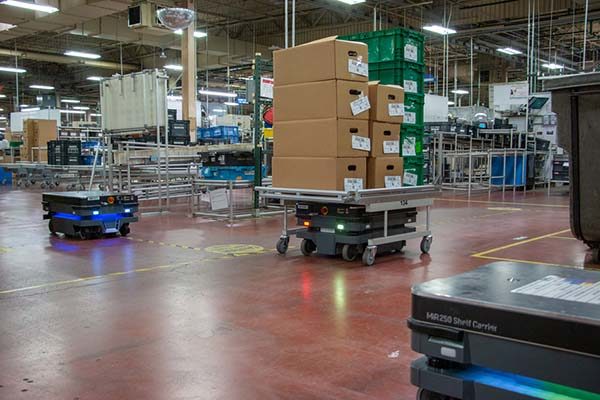Warehouse robots drive change in automotive plant
Autoparts maker Denso freed workers from pushing carts 12 miles a day by bringing in AMRs from Mobile Industrial Robots.

You’re probably a customer of the tier-one automotive parts supplier Denso and don’t even know it. The Kariya, Japan-based Fortune 500 corporation manufactures components for car makers like Toyota, Honda, FCA (Fiat Chrysler Automobiles), General Motors, Ford, Volvo, and Mercedes-Benz. The company’s Denso North America Division is headquartered in Southfield, Michigan, and employs some 24,000 people in the U.S., Canada, and Mexico.
Given the scale of its operations, Denso is always looking for ways to boost efficiency and productivity in its logistics operations. A recent workflow study at its 800,000-square-foot powertrain component production facility in Athens, Tennessee, revealed room for improvement. The research showed that workers were walking up to 12 miles per day moving material between the production areas and the onsite warehouse, spending about 60% of their time pushing carts.
“We knew we had a lot of people that were getting paid to move parts all day long, walking carts from one place to another. But if we have people that are only conveying parts, then that’s a nonvalue-added activity, and we had plenty of open jobs for value-added activities within the production environment,” Denso engineer Travis Olinger said in a release. “We wanted to pay people to make parts for us, [which] makes us money, and not pay them to move parts, [which] costs us money.”
The company began looking into ways to automate the materials transport process, eventually settling on autonomous mobile robots (AMRs) from Danish automated equipment supplier Mobile Industrial Robots (MiR). “Autonomous mobile robots were an obvious choice for our extremely dynamic environment, which we knew would require the robots to make regular route changes,” Olinger said. “After testing AMRs from a few different vendors, we realized that MiR robots bring significant advantages in flexibility, safety, and user-friendliness.”
For the Tennessee facility, Denso chose the MiR250 shelf-lifter model, which it uses in combination with rolling carts from the Danish robotics company Roeq. Olinger said the MiR250 robots were particularly compelling because of their two-meters-per-second speed; their payload capacity of 250 kilograms (550 pounds), which enables them to handle heavy metal parts; and their ability to work in narrow spaces. On top of that, the AMRs can navigate on their own with quick mapping and quick changes, without the need for costly infrastructure built into the facility’s floor—a big plus in the operation’s dynamic environment.
QUICK RESULTS
In the fall of 2020, Denso launched a pilot using six MiR robots to shuttle goods around the Tennessee plant.
Working with MiR partner Advanced Control Solutions (ACS), a factory automation specialist located in Marietta, Georgia, Denso achieved initial setup in a day and deployed the robots after about a week of testing. The partners also developed an information flow to support on-time deliveries, manage charging and proximity cues to prioritize missions, and allow associates on the floor to call for the robots. The Mir250 robots can even automatically open the door to a cleanroom as they enter and exit by sending wireless signals to the rollup door controller.
According to Denso, the pilot produced results within six months, freeing up six workers to move into value-added roles instead of just pushing carts. The company has now expanded the program, using the robots to bring components directly to line-side production on a just-in-time basis. Support for the robots has grown quickly among employees, with workers in other departments requesting robot help in transporting goods like maintenance supplies and spare parts. Denso recently purchased five MiR500 1,100-pound capacity robots for future conveyance projects that require heavier payloads.
Since the pilot’s launch, Denso has successfully executed more than 500,000 missions with the MiRs, realizing a return on investment (ROI) in less than a year, according to the company. And on top of being cost-effective, the AMRs have proved to be extremely reliable, Olinger reports.
“At this point, we’ve been operating MiR robots since September 2020,” he said in the release. “We’ve run over a half million … missions, and they have not called in sick one single day.”Related Articles
Copyright ©2024. All Rights ReservedDesign, CMS, Hosting & Web Development :: ePublishing